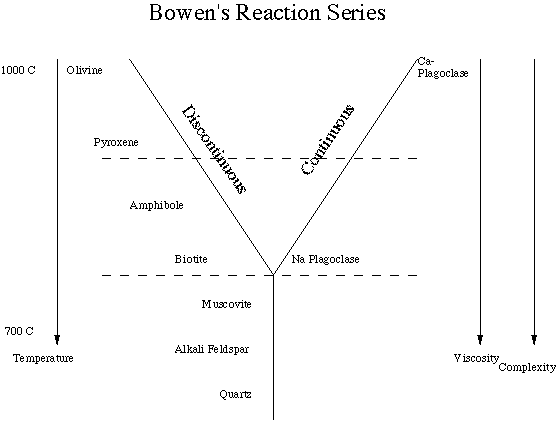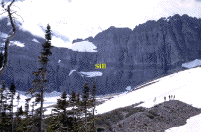Mineralogy -- N.L. Bowen showed that some minerals (and mineral assembledges) are stable at high temperatures, some at intermediate temperatures and some at low temperatures.

- With the singular exception of quartz, the other phases present represent solid solution series; that is, their composition varies between fixed limits.
- The viscosity (resistance to flow) of a melt (magma/lava) increases with decreasing temperature; the viscosity of a melt is lowered if water is present in the melt.
- The complexity (amount of sharing of the oxygens of the silicon-oxygen tetrahedra) increases with decreasing temperature.
- The dashed lines are drawn to reflect three mineral assemblages :
- high temperature - olivine, pyroxene and Ca-rich plagioclase;
- intermediate temperature - amphibole, biotite and Na-rich plagiolase; and
- low temperature - muscovite, alkali feldspar and quartz.
- Bowen's Reaction Series points out that there are commonly occurring mineral assemblages (based on similar temperatures of formation/crystallization). For example, quartz and olivine (at least the magnesium-rich variety) are not expected to occur together as an equilibrium assemblage.
- Several of the minerals (amphibole, biotite and muscovite) must contain (OH)- or one of the Halogens (F-, or Cl-). Thus, these minerals will only crystallize from a wet melt.
- The minerals on the discontinuous side of the reaction series are called mafics; they are enriched in iron and magnesium.
- The following table illustrated one way (admittedly quite over-simplified) that a geologist could choose to classify igneous rocks. The two dimensions are texture (cooling rate) and mineralogy (a minimum estimate of highest temperature reached by the melt). Note that the feldspars represent a wide range of temperatures -- Calcium-rich Plagioclase, Sodium-rich Plagioclase and Alkali Feldspar. Quartz occurs in both granites and rhyolites.
Texture Alkali Feldspar Sodium Plagioclase Calcium Plagioclase
Phaneritic Granite Diorite Gabbro
Aphanitic Rhyolite Andesite Basalt
Geoscientists at the University of British Columbia has prepared a nice figure which summarizes information about the Classification of Igneous Rocks. Take a look at their companion piece on the Rock Cycle.
Note that a granite is the coarse grained equivalent of a rhyolite. That is, if the rate of cooling is very slow a granite will form. The same melt, cooled rapidly, will form a rhyolite.
The relationship between temperature and mineralogy allows another over-simplification that relates igneous rock type to plate tectionic setting:
- Grabbro/Basalt -- Divergent Margins
- Diorite/Andesite -- Convergent Magrins - Subduction Zones
- Granite/Rhyolity -- Convergent Margins - Continent/Continent Collision
